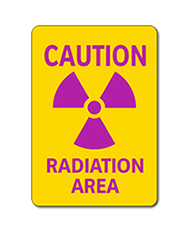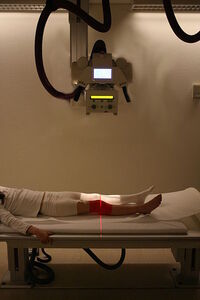Dear Dr. Zoomie – I work in a laboratory where we use x-ray machines on a regular basis. When the machine is on we have measured dose rates of up to 100 mR/hr in parts of the lab and as high as 50 mR/hr in the storage room on the other side of the wall from the x-ray machine. The previous RSO never posted these rooms as radiation areas, even though the regulations say that anyplace where dose rates are higher than 5 mR/hr have to be posted. Did my predecessor screw up, or do we have to post these rooms as radiation areas?
Great question! And it also brings up one of the fine points when it comes to hanging radiation area signs. In fact, the important thing isn’t so much the maximum dose rate you can measure at any one time but, rather, the radiation dose a person can receive when the room(s) and machine(s) are used on a routine basis. In fact, according to 10 CFR 20.1003 (definitions), “Radiation area means an area, accessible to individuals, in which radiation levels could result in an individual receiving a dose equivalent in excess of 0.005 rem (0.05 mSv) in 1 hour at 30 centimeters from the radiation source or from any surface that the radiation penetrates.” So, using this definition, let’s see what the difference is between “5 mrem per hour” and “5 mrem in one hour.”

Say, for example, that your x-ray machine is usually used only about 5% of the time on a typical day and never more than 10% of the time – this is the time that the machine is actually turned on (time preparing for an x-ray doesn’t count). This is called the machine’s workload and is abbreviated as W (it can also be called the utilization factor, abbreviated U). If you are in this room for an hour with the machine used the way it’s normally used, in one hour you can receive a radiation dose of only 10 mR (100 mR/hr when the machine is used x 10% of the time the machine is in use). In the adjacent room a person would receive a dose of 5 mR in one hour with the machine in normal use. So – taking into account only the machine’s workload – you might have to post both of these rooms as radiation areas. But what if you also take into account how the rooms are used?
You said that the adjacent room is a storage room – it’s a pretty good guess that nobody stays in this room 100% of the time. In fact, a reasonable occupancy factor (abbreviated as O) for storage areas is about 5%. So, using your understanding of how both the machine AND the room are used you find out that, even though the highest dose you measure in the storage room is 50 mR per hour, a person using that room the way it’s normally used when the machine is used the way it’s normally used will receive a radiation dose of less than 1 mR in an hour. Or, mathematically, this is how it looks:
D (in one hour) = DR x O x U
D (in one hour) = 50 mR/hr x 5% occupancy x 10% workload
D (in one hour) = 50 x 0.05 x 0.1 = 0.25 mR
So – even though the storage room might have dose rates as high as 50 mR/hr, you don’t need to post it as a radiation area because of your knowledge of the way the room is used combined with your knowledge of the way the machine is used.
We still have your lab to worry about. With a dose rate of 100 mR/hr when the machine is on you could be justified in posting the room as a high radiation area. On the other hand, we’ve already seen that, with the machine’s maximum workload, a person in the room would receive a dose of about 10 mR in one hour – this would make the room a radiation area, but not a high radiation area. If people normally stay in this room all the time then you’d stop here. On the other hand, if people come and go then you can apply the occupancy factor to your lab as well to figure out how to post your lab.

There are two important points to keep in mind here.
One is that this is a way to credit for how your normally use the rooms and the machines (or radiation sources) – it is not meant to be a way to “pencil-whip” your numbers to avoid regulatory trouble. Use legitimate numbers when you’re doing these calculations, not the numbers you need to use to get the result you want. For example, you can look up occupancy factors online or you can measure them yourself by observing a room for a few days. And you can use equipment logs to determine a machine’s workload. But you need to be able to justify every number that you use when you’re trying to figure out the amount of dose a person is likely to receive in one hour.
The other point is that you can’t go wrong by posting a room based on the actual dose rates, leaving out the occupancy factor and machine workload. But if you don’t want to post, say, a hallway or stairwell or storage room (or laboratory) you can use these calculations to find out whether or not a posting is really necessary.
Finally, this same calculation is the same whether you’re talking about an x-ray machine in a laboratory (or in a hospital), a linear accelerator used for cancer treatment, or a radioactive source. As long as you know the highest radiation dose rate, the occupancy factor, and the workload you can make this determination.
Hopefully this helps!